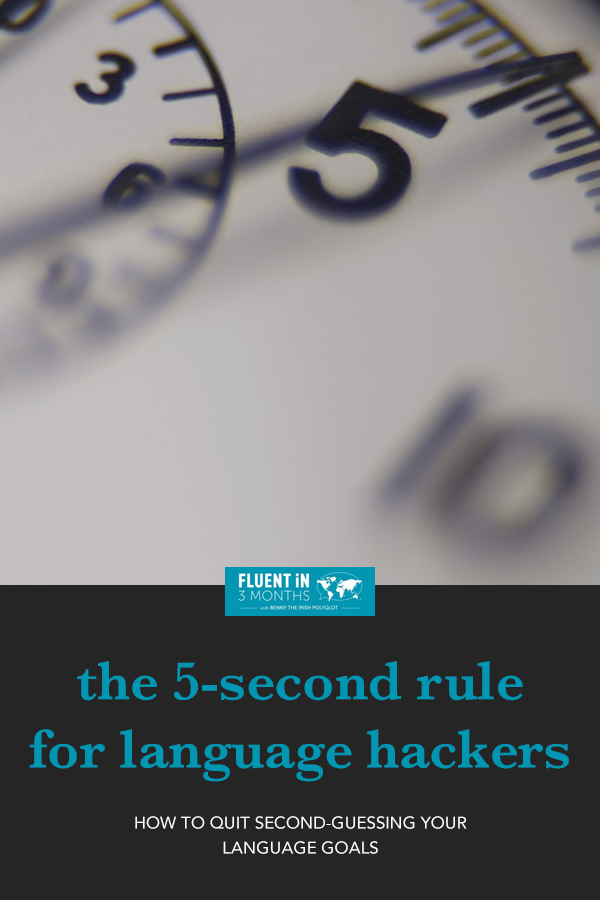The 5-Second Rule for Language Hackers
Feelings play a much bigger role in language learning than they’re given credit for.
This isn’t something that’s often talked about, so let me clear the air and say it straight up: Whether you succeed (or fail) at learning a new language has a lot to do with how you manage your emotions.
Perhaps that’s why the simplest things about language learning can often seem the hardest.
We know what we're supposed to be doing. After all, we've all heard the same advice over and over again:
“Just get out there and start speaking a language!”
“Be consistent and stick to a learning plan.”
“If you think you don't have enough time, then make time!”
The truth is, we may want to learn a language, but when it comes to asserting ourselves and actually doing something about it, we often end up falling short. We want to learn a language, but our feelings about learning (or about the language) get in the way.
When we stop and think about making a change in our lives, our brain is trying very hard to talk us out of it. Learning a new language requires doing things that are both unfamiliar and scary. Our brain is afraid of these things and will employ all kinds of psychological tricks to keep us from leaving our comfort zone.
That's why being motivated and knowing what to do are sometimes not enough. We also need the ability to flip that switch inside ourselves to unlock our potential.
What is the 5-Second Rule?
The rule was conceived by bestselling author Mel Robbins who explains it this way:
“Anytime there is something you know you should do, but feel uncertain, afraid or overwhelmed, count 5-4-3-2-1 and move when you get to 1.” – Mel Robbins
You're probably rolling your eyes right now. How can something so simple actually work?
Call it a Jedi mind trick, a productivity hack, or whatever you want. The 5-second rule is based on “metacognition,” which in layman's terms, refers to strategies that let you defeat your own brain to accomplish your goals.
By counting down, you are interrupting the train of thought that is preventing you from taking action. When you get to “1”, you move and start “doing”, so that all the doubts, fears, and paralyzing thoughts won't get a chance take hold of you again.
It’ll probably take some time to train yourself to use this rule, but once you get used to it, it can be an extremely powerful tool to improve your language learning results.
Here are 4 ways you can put the 5-second rule to use in your language learning:
1. Quit Second Guessing Your Language Goals
There are countless stories about people who've learned a language in just a few months. But even after reading these, maybe you still have doubts as to whether you can really succeed.
You're not sure whether it's the right time to start learning, or maybe you don't feel ready to fully commit.
So instead of doing what it really takes to learn, you go about it halfheartedly, playing around with free apps for a few minutes a day, or passively listening to Spanish radio while making dinner.
If you're stuck in limbo, use the 5-second rule to dismiss your doubts and make a meaningful, genuine commitment to learning. It's about finding the courage to stop overthinking and start taking action.
For some people, taking action means reaching out to someone for a conversation exchange, for others it will mean signing up for lessons with a Spanish tutor, or blocking out an hour every morning in your calendar for learning.
Whatever it may be, when that countdown reaches “1”, you have to physically do something.
This is as much about developing inner strength as it is about making something happen. When the rule is applied in this way it can teach you how to finally stop doubting yourself and to start believing in your abilities.
2. Take the Plunge and Start a Real Conversation
You probably already know that the best way to learn a language is to speak it.
But speaking is also one of the hardest parts of language learning for many people. Imagine this scenario:
One day, you park your car next to your office, and as you go to pay for parking, you see a man struggling with the ticket machine. He looks confused and mutters to himself: “¿Como funciona esto?” (How does this work?).
What luck! Wouldn't this be a great opportunity to practice your Spanish and help someone out at the same time?
To break the ice, a simple “¿Buenos días, usted necesita ayuda?” (Good morning, do you need help?) would do the trick.
But there's a little voice in your head that says:
- “Nah, it's not worth it.”
- “Maybe he doesn't want your help.”
- “What do you say after that?”
- “Look, he's starting to walk away, it's too late.”
This voice is a natural defence mechanism. Its sole goal is to protect you from rejection and potential embarrassment. There's no way to completely silence this voice because it's hard-wired into your biology.
However, by counting down 5-4-3-2-1, you can act on your initial instinct and talk to a stranger before your little voice can convince you that it's a bad idea.
If you can use the 5-second rule every time you are faced with an opportunity to speak, you'll eventually become more comfortable with these situations. You'll be more relaxed, which leads to more positive interactions, and your confidence will snowball.
3. Beat Your Frustration When You Hit a Plateau
Language learning is never a linear path. You may see rapid improvement for a few months, and then all of a sudden you hit a wall:
- Grammar starts to get really complicated and your brain hurts just thinking about it.
- Listening to a native speaker feels like trying to catch bullets, as their words come out like machine gun fire.
- You memorize new phrases but draw a blank when you actually want to use them.
- Your pronunciation still sucks.
Lack of progress can be extremely frustrating and sometimes we are our own biggest critic. People have the tendency to worry and doubt themselves to the point that it becomes a force of habit.
“Maybe I'm just not cut out for this”, some would say.
When these emotions reach a boiling point, that's when people give up learning a language altogether, or they “take a break” and try to pick it up again months or years later when the scars have healed.
If you ever find yourself feeling this way, taking 5-seconds to calm your emotions is just what you need. The countdown pushes the negative thoughts out of your mind and resets your brain, allowing you to take control of it.
Once you are in control, you'll be able to redirect your thoughts towards positivity and patience. Ground yourself with the realization it's normal to experience setbacks in language learning. You have to figure out what's holding you back, make the necessary adjustments, and continue to push onwards.
4. Keep Yourself from Slacking Off
Your Spanish Meetup group starts in 30-minutes. It's cold outside, and the wind is howling. Your car is buried under a foot of snow. A warm blanket and Netflix beckon you to stay at home.
“Maybe I'll just go next week.” you think to yourself.
At this point, you'll probably start rationalizing this decision. Maybe next week you'll stay twice as long to make up for it. Maybe you'll watch an episode of Narcos tonight so that at least you'll get to listen to some Spanish. That's better than nothing right?
Finding the courage to start something is the hardest part. When you do show up to the Meetup, you'll probably have a great time and wonder why you were so hesitant to go in the first place. But too often people succumb to procrastination because it's always easier to do nothing.
The 5-second rule is perfect for pulling yourself away from destructive habits like this. As you are counting down, you are ignoring the lazy part of you that's telling you “I don't feel like it.” When you reach “1”, you're not just opening the door to the blowing snow, you're opening the door to a better version of yourself.
Sometimes it's the small decisions in your everyday life that matter the most. By accumulating little victories like this over time, you're setting yourself up for big changes and even greater results.
How to Start Practising the 5-Second Rule Today
The 5-second rule is a tool. Like any tool, the more you use it, the more skilled you become at wielding it. If you stop using it, then you'll most likely revert back to your old patterns, which are very deeply ingrained.
To ease your way into things, start with something small, like waking up in the morning. Instead of reaching over and hitting that snooze button, count 5-4-3-2-1 and jump out of bed.
As you continue to practice the 5-second rule, you'll confront the bad habits, fears, insecurities and excuses that have held you back for years.
Over time, you'll be able to conquer them, attain higher levels of confidence, and take giant steps towards becoming fluent in a new language.
So try it out yourself, and tell us in the comments about your experience with the 5-second rule.




Social